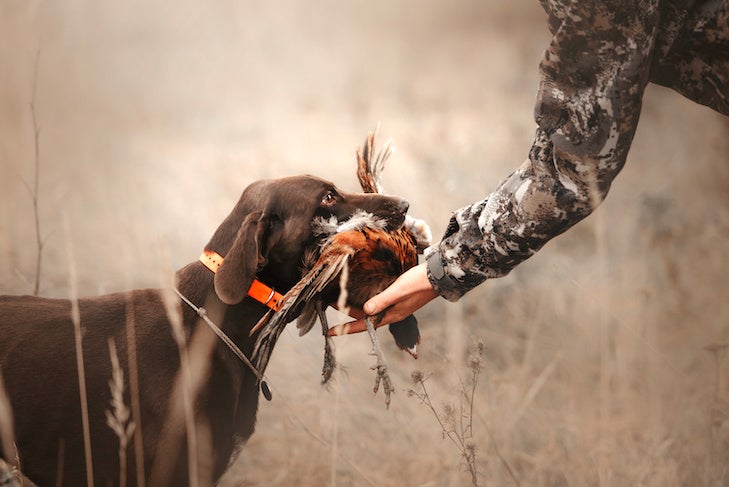AKC is a participant in affiliate advertising programs designed to provide a means for sites to earn advertising fees by advertising and linking to akc.org. If you purchase a product through this article, we may receive a portion of the sale.
Hunting with dogs is an exciting way to experience outdoor life together. Dogs have been hunting with humans for millennia. Many hunting breeds were actually developed specifically to find, flush out, or retrieve game. But that doesn’t mean that your dog will automatically know what to do on a hunt.
Before you head out in search of game with your dog, you’ll need to train them. Aside from helping you find and retrieve the quarry you’re after, dogs also must become used to loud sounds like gunshots. You’ll also need to bring along the proper hunting gear necessary to keep your dog safe and satisfied in the field.
Get Your Dog Used to Gunshots
Gunshots are loud, and the sound can spook your dog into running off in the middle of a hunt. That’s why gun training is so important. Cara Harper is an expert in the field who regularly hunts with her Labrador Retrievers, Nita and Rou.
Harper and her husband trained their dogs by running retriever drills for the dogs, tossing a decoy “bumper” for the dogs to fetch. At the same time, to start with, one of them would fire a gun 100 yards away. “The shooter fires a shot as the dog leaves to make a retrieve. With each retrieve, the shooter eases closer from behind the handler and dog,” says Harper.
Reward your dog as they slowly get used to the shots. Continue the process gradually, until the gunner is eventually right beside the dog when shooting.

Train Your Dog to Help Locate Game
“Obedience is the keystone that all other training is built off,” says Harper. “If a dog won’t do a sit/stay for a short period of time on a stand, then there is no way that they’ll have the control to sit through an exciting duck hunt.”
Trainer Barton Ramsey recommends starting obedience training when your dog is 8 weeks old. He recommends starting retrieval training when they’re 6 to 7 months old. By this point, your dog will have the necessary skills and physical ability to handle more demanding tasks.
When teaching dogs to find and flush out game, Harper suggests running quartering drills regularly. Quartering drills teach your dog to run back and forth ahead of you in a zigzag pattern. This allows them to locate more game than walking in a straight line. You can set up bumpers to guide your dog in this pattern, and use slight arm movements to help guide your dog. After the dog approaches each bumper, praise your dog or give them a tasty treat.
Train Your Dog to Retrieve Game
An excellent way to train your hunting dogs to retrieve game is to simulate a hunting scenario using decoys. Repeat the training on land and in water. This helps dogs get acclimated to different kinds of terrain.
“We’ll have a bird boy one hundred or so yards out in a field blow a duck call and catapult a bumper into the air so that the dog sees it fall,” says trainer Bob Owens. “The dog will then run out and bring back the bumper. Eventually, the dog learns to watch the sky for falling birds and to mark their location so that your dog knows where to find them for the retrieve.”
Blind retrieve training is also critical, since it allows you to guide a dog to a fallen bird that they might not have seen fall. Perfecting blind training can be challenging, and Harper suggests learning to guide your dog by using a series of dog whistles and/or hand signals.

Test Hunting Skills and Reinforce Training
Before hunting with dogs, consider participating in AKC Retriever Field Trials and hunting tests. Hunt tests help show you how well your dog will perform in the field. Field trials, meanwhile, let more experienced dogs show off their skills on the hunt. Plus, the events are geared towards the unique skills of different breeds, including Pointers, Retrievers, and Spaniels.
Harper and Owens regularly participate in both field trials and hunt tests with their dogs. Owens also participates in events through the Master National Retriever Club. These hunt-focused events ensure that his dogs are ready for the hunt and help keep dogs active and in shape during the off-season.
Pack Proper Hunting Supplies
While hunting with dogs, you’ll need to bring along some gear to keep them comfortable and safe. It’s always a good idea to put your dog in an easily-seen orange safety vest. That way, other hunters can easily spot them.
Jennifer Danella regularly hunts with her Labrador Retriever L.K. and Beagles Remington and Beretta. “Any hunt I bring my dogs on, I have a first-aid kit filled with bandaging material, wound care items, and other emergency supplies,” says Danella. “For waterfowl hunting, my retriever L.K. wears a buoyant vest. She has her own hunting blind and elevated stand to stay warm and safe in the elements.”
Melissa Bachman hunts alongside her dog Pork Chop. She brings plenty of supplies to keep Pork Chop well-fed and hydrated. “I always bring water and food dishes, a toy, and treats to keep in my pocket,” says Bachman. “When we hunt out west, I bring along extra water bottles and a travel-size bottle of dog shampoo. Pork Chop likes to find fresh cow pies and roll in them.”
Whether you hunt regularly with your dogs or simply want to participate in some fun sporting events that focus on your dog’s natural hunting abilities, consider checking out AKC performance sports. You’ll also find lots of upcoming events to choose from, so you can find one that’s right for your dog.

